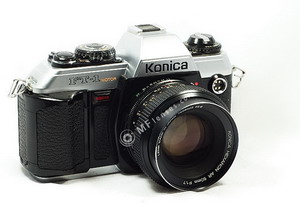Konica FT-1 Review |
|
Konica FT-1 was one of the last SLRs in the Konica product line. FT-1 was an improvement on the earlier FS-1 with a different meter type, improved quality of electronics and a faster winder speed. Sadly today most of them are in non-working condition. If you find a working one, it is a excellent camera and quite amazing how small it is despite having a built-in motor drive.
Newly added features are the exposure compensation knob and a switch to toggle between continuous (up to 2 frames per second) and single shot exposures. Viewfinder is large and bright with a clear and accurate split-screen focus aid; ergonomics are great, the controls all being well-placed and easy to adjust.
Camera
Fact SheetSpecifications of the Konica FT-1 Motor
Type: 35mm focal plane shutter TTL-AE single-lens reflex camera with built-in auto-winder
Format: 24 x 36mm negative (standard 35mm film)4.butkus.org
Standard lenses:
Hexanon AR 40mm f/1.8
Hexanon AR 50mm f/1.8
Hexanon AR 50mm f/1.4
Hexanon AR 57mm f/1.2
Lens mount: Bayonet Konica mount II
Aperture control: Fully automatic and manual
Shutter: Digital-control vertical action electronic metal focal plane shutter
Shutter speeds: B. 2, 1 - 1/1000 see, equally calibrated in 1:1 progression
Synchro: Hot shoe and X contact with synchro socket, automatically set to 1/100 sec with dedicated Auto-Electronic
Flash. Manually set to 2 - 1/60 see with non-dedicated electronic flash. Synchronized with M, FP and ME bulbs at
1/30 see and slower shutter speeds.
Self-timer: Digital-controlled self-timer with a duration of 10 sec. Operation indicated by LED. Self-timer action
may be cancelled.
Finder: Pentaprism eye level finder, shows 92%of picture field magnification 0.81 at the center. Central split-image
spot plus microdiaprism on matte focusing screen.
Finder display: LED dot display indicates aperture opening in AE mode, over/under exposure warning, low voltage
warning, manual mode setting and correct aperture setting for manual mode, electronic flash ready light, correct
aperture setting for stopped-down shooting.
Metering system: TTL center-weighted metering at the full lens opening. Silicon-pin Photo Diode (SPD) compound
photocell.
Exposure adjustment: Shutter-speed priority aperture control metering system. Coupled to film speed, shutter speed
and f-stop value at the full lens opening with Hexanon AR lens (metering at full lens opening). Automatic aperture
control with priority given to shutter speed in the AE mode. Correct aperture value reading in the manual mode. Fixed
point alignment system coupled to film speed, shutter speed and aperture with Hexanon lens, bellows, etc. (stopped
down metering).
AE coupling range: EV 0.7 (f/1.8 at 2 see) to EV 19 (f/22 at 1/1000 see) with ASA/ISO 100
Film speed range: ASA/ISO 25-3200
Main switch: Turns power source on and off and controls the AE lock
AE Lock: When main switch set at 'AEL' partial depression of shutter release shows aperture setting in finder and
locks aperture at that setting (over/under exposure warning inactive in ALL mode)
Exposure compensation: +2EV, 1/3 step intervals (at ASA25, -2 to 0 EV, at ASA3200, +2 to 0 EV)
Shutter release: Electromagnetic release partial depression of shutter activates light meter full depression of shutter
triggers shutter.
Single/continuous advance: S/C switch for single frame auto winding or continuous-shooting at 2 fps
Film transport capacity: With 36-exposure film continuously used at constant temperature, more than 20 rolls with
AAA alkaline batteries, more than 10 rolls with AAA manganese batteries, more than 40 rolls with AA alkaline
batteries more than 20 rolls with AA manganese batteries (under Konica's test conditions) before low voltage warning
appears in viewfinder.
Film loading: Auto-loading system
Film advance: Auto-winding system with electric motor. Index mark turns in the film advance window to indicate
positive film wind
Film rewind: Crank system, LED end of roll indicator. Rewind button automatically returns to the original position.
Automatic resetting frame counter.
Dimensions and weight: 143 x 91 x 46mm (5.6" x 3.6" x l.8") 570g (20.1 oz) (without batteries) 143 x 91 x 78mm
(5.6" x 3.6" x 3.1") 740g (26.1 oz) with 50mm f/1.8 lens (without batteries)
User CommentsMy favorite SLR from all I wish only a more reliable electronics
(Ian)
Plastic exterior, steel interior, electronically controlled, autowinding, autoloading.
It's a full-featured, well-built, reliable, top-of-the-line, professional camera, with a ton of system accessories. Even though it dates to the mid-1980s and has a motor drive,
it's still a pretty quiet camera--certainly quieter than any external motor drive I've been around. I would say that it definitely was designed to be a shutter-priority camera; although,
it still works fine in manual, but the metering display becomes a little awkward to use.
(Conan)35mm focal plane shutter
TTL-AE single-lens reflex camera |


This camera with the Hexanon 40/1.8 has given me some of the best pictures, that I have ever taken.
Uses batteries that are easy to find. A fety usable Kibica camera.
The electronics inside is mounted on maybe a half dozen flexible printed circuit boards. The boards are interconnected by a small flap with bare contacts that is clamped to bare contacts on the other board. They put a grease on the contacts, I suppose to keep out moisture and corrosion, but over time, that grease turned out to be mildly corrosive itself, and the contact points turn green and loose their connection.
If you are mechanical, have the patience to take things apart without forcing anything, and don't mind working on small things (an optivisor or even the drug store reading glasses is a big help) get yourself a service manual (ebay) and try it out. This is truly a wonderful camera, and dead ones are ultra cheap. Try it out, you have little to loose and a lot to learn! It is truly amazing to see what they fit in there without computers and CAD systems!